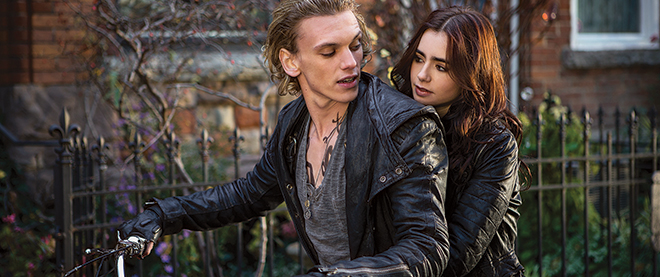Mortal Instruments: City of Bones
How the saga of Clary Fray pushes more boundaries than its girl-powered predecessors
Rafy / Sony Pictures
Share

Vampires and werewolves; “mundanes” and magicals; blood (lots) and sex (hinted); rebel angels and kids who don’t know their own powers: If you think, as the hype builds for the Aug. 21 release of the film version of City of Bones, that you’ve seen the constituent parts of Cassandra Clare’s bestselling Mortal Instruments series before, you have. Familiar too—after Twilight and The Hunger Games—will be the love triangle, of the two- guys-and-one-girl variety. That’s because the saga of Clary Fray, 15-year-old (going on 16) demon-killing shadow-hunter and her tangled family-and-friends situation, is the third in an unbroken chain of hugely popular girl-dominated fantasy franchises.
“It’s been a long time coming,” says Clare, 40. “When I was a girl, I read a lot of boy fantasy because the game was rigged—there was no Star Wars for girls. In the movies, a girl fantasy character wasn’t thought capable of opening anything except a Disney princess flick. Even Twilight didn’t convince the studios. They thought, ‘Must be the vampires!’ but Hunger Games knocked down the last barrier—that coming-of-age story, that particular female lead, brought millions to the box office.”
The triumph of the girls has allowed Clare to push even more boundaries. The ingredients in her story may be eternal, but the mix is contemporary. The de rigueur love triangle quickly becomes a pentangle with a clear nod to a sixth participant—the author will need her in order to emerge with three happy couples—and the sexual boundaries are more fluid. J.K. Rowling didn’t declare the great wizard Dumbledore to be gay until after the final Harry Potter volume was in print, and it’s difficult to find any importance to the Potter storyline in that fact. But, as Clare notes, her gay characters “are not just gay on the page.” Their relationships, and the prejudices they evoke even among the shadowhunters—a “rigid and hierarchical” band of violent do-gooders nevertheless inclined to homophobia—help drive the plot.
They are also important parts of what’s propelled Mortal Instruments to sales of six million copies in 35 languages. Any successful young-adult series dangles its true hooks beneath surface glamour, reeling in its devotees by the characters’ relationships and its coming-of-age story. Melissa Bourdon-King, general manager of Mabel’s Fables bookstore in Toronto and a huge fan of the series, says, “I love it when teens reading an exciting story are also grappling with all kinds of issues without even noticing it until they think, ‘Wait, what if I apply this thought to my mom or my science teacher . . .’ ”
Female lead or not, Bourdon-King knows boys are reading the series—and why not, as “there are lots of moody male characters for them.” City of Bones was filmed in Toronto, and the day Bourdon-King was invited to the set at a “secret” location near Pearson International Airport, “there were 20 or so fans who had figured it out, clustered outside, hoping for Cassie’s autograph—and seven or eight of them were boys.”
Clare, who has heard from industry sources that the male segment of her readership is “unusually high” for a female fantasy writer, agrees with Bourdon-King that the boy fans keep their presence low-key. “They’re much less likely to make their reading a social activity the way girls make their friends read books they love, and get together to talk about them and even do a little cosplay” by dressing up as the characters, she says.
Boys do email her, Clare says, and when they do, “they exhibit very strong feelings about the relationships.” Her favourite email, however, came from an 11-year-old, who wrote that he related to one male protagonist “because, like him, I am often considered quite handsome.”
If there is a root cause for girl-powered fantasy’s days of glory beyond the quality of the stories themselves, that’s probably it. Once upon a time, girls read boys’ action-heavy, relationship-light stories because that’s all there was; now the mix is much more balanced, enticing girls and—more quietly—boys alike. If that’s the case, the girls may rule for a long time to come.